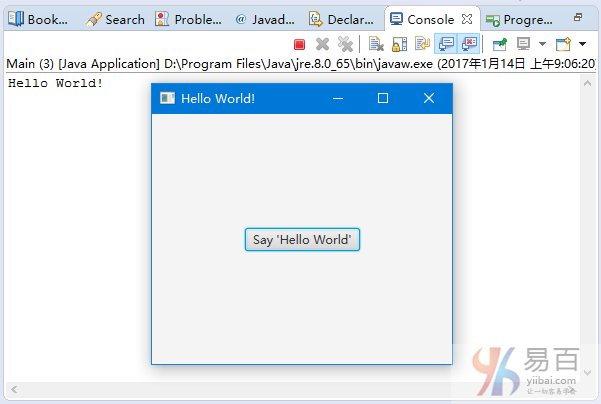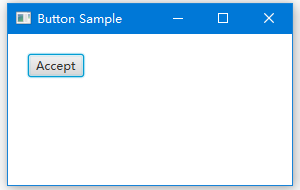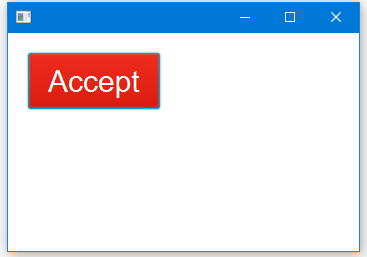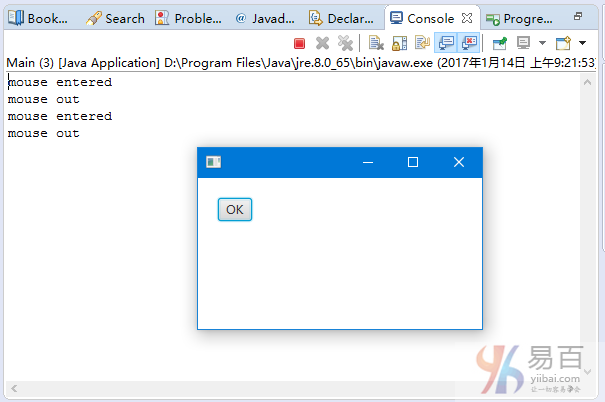JavaFX按鈕
當使用者單擊按鈕時,JavaFX Button類可以觸發事件。Button類擴充套件了Labeled類,可以顯示文字,影象或兩者都可以。
以下程式碼顯示了如何向Button新增單擊操作偵聽器。
import javafx.application.Application;
import javafx.event.ActionEvent;
import javafx.event.EventHandler;
import javafx.scene.Scene;
import javafx.scene.control.Button;
import javafx.scene.layout.StackPane;
import javafx.stage.Stage;
public class Main extends Application {
public static void main(String[] args) {
launch(args);
}
@Override
public void start(Stage primaryStage) {
primaryStage.setTitle("Hello World!");
Button btn = new Button();
btn.setText("Say 'Hello World'");
btn.setOnAction(new EventHandler<ActionEvent>() {
@Override
public void handle(ActionEvent event) {
System.out.println("Hello World!");
}
});
StackPane root = new StackPane();
root.getChildren().add(btn);
primaryStage.setScene(new Scene(root, 300, 250));
primaryStage.show();
}
}
上面的程式碼生成以下結果。

建立按鈕
我們使用以下建構函式在JavaFX中建立一個Button。
建立帶有空文字標題的按鈕。
Button button = new Button();
建立具有指定文字的按鈕。
Button button = new Button("OK");
要建立帶有文字和圖示的按鈕。
Image imageOk = new Image(getClass().getResourceAsStream("OK.png"));
Button button = new Button("OK", new ImageView(imageOk));
按鈕內容
建立JavaFX Button物件後,我們可以使用以下方法設定文字並設定安裝圖示。
setText(String text)- 設定按鈕的文字標題setGraphic(Node graphic)- 設定圖示
除了ImageView物件,我們可以使用javafx.scene.shape包中的形狀作為Button中的圖形元素。
setGraphicTextGap方法設定文字和圖形內容之間的差距。
以下程式碼將影象安裝到按鈕。
Image okImage = new Image(getClass().getResourceAsStream("OK.png"));
button.setGraphic(new ImageView(okImage));
按鈕操作
我們可以使用Button類的setOnAction方法為使用者單擊事件新增點選事件處理程式。
button.setOnAction((ActionEvent e) -> {
System.out.println("clicked");
});
按鈕效果
我們可以將javafx.scene.effect包中的效果應用到按鈕。
以下程式碼將DropShadow效果應用於按鈕。
DropShadow shadow = new DropShadow();
button.setEffect(shadow);
button.setEffect(null);//remove the effect
以下程式碼顯示了如何為Button設定陰影效果。
import javafx.application.Application;
import javafx.event.EventHandler;
import javafx.scene.Group;
import javafx.scene.Scene;
import javafx.scene.control.Button;
import javafx.scene.effect.DropShadow;
import javafx.scene.input.MouseEvent;
import javafx.scene.layout.VBox;
import javafx.stage.Stage;
public class Main extends Application {
DropShadow shadow = new DropShadow();
public static void main(String[] args) {
launch(args);
}
@Override
public void start(Stage stage) {
Scene scene = new Scene(new Group());
stage.setTitle("Button Sample");
stage.setWidth(300);
stage.setHeight(190);
VBox vbox = new VBox();
vbox.setLayoutX(20);
vbox.setLayoutY(20);
final Button button1 = new Button("Accept");
button1.addEventHandler(MouseEvent.MOUSE_ENTERED, new EventHandler<MouseEvent>() {
@Override
public void handle(MouseEvent e) {
button1.setEffect(shadow);
}
});
button1.addEventHandler(MouseEvent.MOUSE_EXITED, new EventHandler<MouseEvent>() {
@Override
public void handle(MouseEvent e) {
button1.setEffect(null);
}
});
vbox.getChildren().add(button1);
vbox.setSpacing(10);
((Group) scene.getRoot()).getChildren().add(vbox);
stage.setScene(scene);
stage.show();
}
}
上面的程式碼生成以下結果。

按鈕樣式
我們可以使用CSS樣式來改變按鈕的外觀和感覺。在單獨的CSS檔案中定義樣式,並通過使用getStyleClass方法應用CSS檔案。
下面的程式碼是一個CSS檔案,它改變了按鈕的字型和顏色。
.button1{
-fx-font: 30 arial;
-fx-base: #ee2211;
}
然後我們使用下面的程式碼來安裝CSS。
button.getStyleClass().add("button1");
-fx-font屬性設定button1的字型名稱和大小。 -fx-base屬性覆蓋預設顏色。
下面的程式碼顯示了如何使用CSS來改變Button的外觀。
import javafx.application.Application;
import javafx.event.ActionEvent;
import javafx.event.EventHandler;
import javafx.scene.Group;
import javafx.scene.Scene;
import javafx.scene.control.Button;
import javafx.scene.layout.VBox;
import javafx.stage.Stage;
public class Main extends Application {
public static void main(String[] args) {
launch(args);
}
@Override
public void start(Stage stage) {
Scene scene = new Scene(new Group());
stage.setWidth(300);
stage.setHeight(190);
VBox vbox = new VBox();
vbox.setLayoutX(20);
vbox.setLayoutY(20);
Button button1 = new Button("Accept");
button1.setStyle("-fx-font: 30 arial; -fx-base: #ee2211;");
vbox.getChildren().add(button1);
vbox.setSpacing(10);
((Group)scene.getRoot()).getChildren().add(vbox);
stage.setScene(scene);
stage.show();
}
}
上面的程式碼生成以下結果。

按鈕滑鼠事件
以下程式碼顯示了如何處理Button的Mouse in和Mouse out(滑鼠移入和移出)事件。
import javafx.application.Application;
import javafx.event.EventHandler;
import javafx.scene.Group;
import javafx.scene.Scene;
import javafx.scene.control.Button;
import javafx.scene.input.MouseEvent;
import javafx.scene.layout.VBox;
import javafx.stage.Stage;
public class Main extends Application {
public static void main(String[] args) {
launch(args);
}
@Override
public void start(Stage stage) {
Scene scene = new Scene(new Group());
stage.setWidth(300);
stage.setHeight(190);
VBox vbox = new VBox();
vbox.setLayoutX(20);
vbox.setLayoutY(20);
final Button button1 = new Button("OK");
button1.addEventHandler(MouseEvent.MOUSE_ENTERED,
new EventHandler<MouseEvent>() {
@Override
public void handle(MouseEvent e) {
System.out.println("mouse entered");
}
});
button1.addEventHandler(MouseEvent.MOUSE_EXITED,
new EventHandler<MouseEvent>() {
@Override
public void handle(MouseEvent e) {
System.out.println("mouse out");
}
});
vbox.getChildren().add(button1);
((Group) scene.getRoot()).getChildren().add(vbox);
stage.setScene(scene);
stage.show();
}
}
上面的程式碼生成以下結果。
